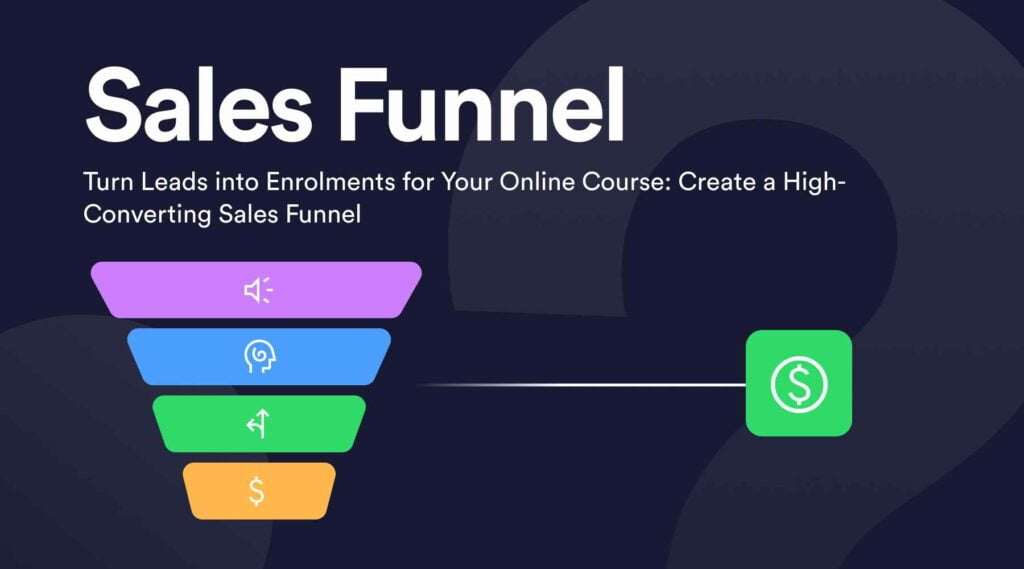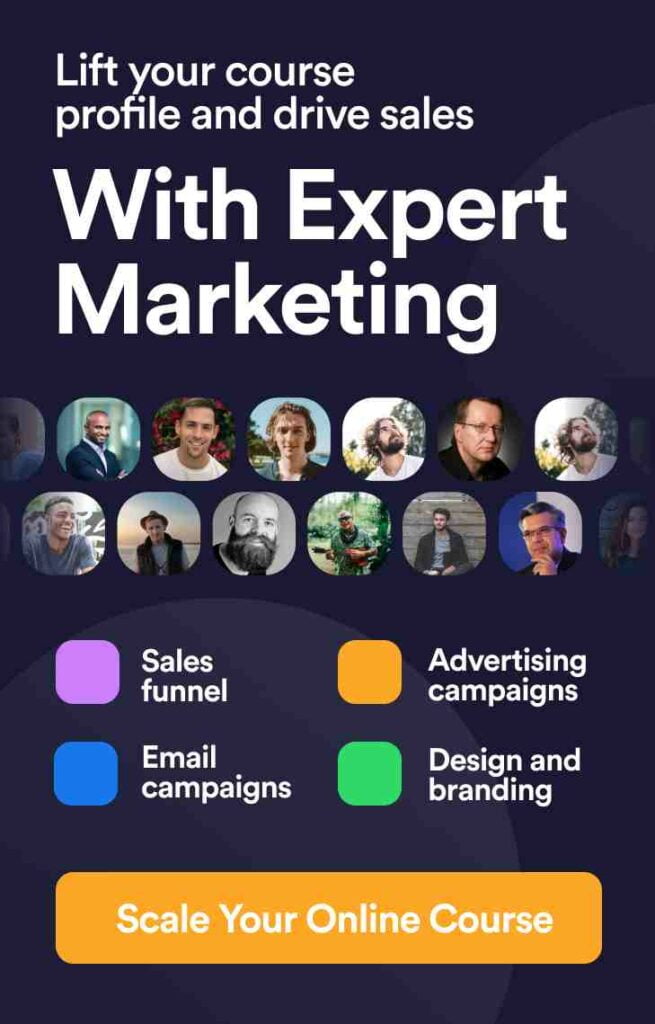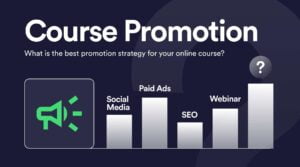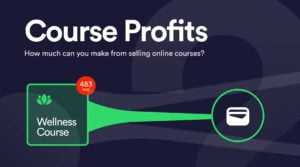Turn Leads into Enrolments for Your Online Course: Create a High-Converting Sales Funnel
INTRODUCTION
Here’s the frustration. You’re an expert in your field, and you’ve created, or are busy creating, a great course that you know will benefit many people. But you don’t know how to reach them and market to them.
You’ve heard about different marketing strategies, sales funnels, email marketing, ideal target markets, A/B testing, and a whole lot more, but the thought of dipping your toes into marketing makes you want to give up on your plan for an online course altogether.
Sound familiar? Then keep reading – this article is just for you!
How The Transformation of The Online Course Market Affects You
It’s no secret. The online course and education market has experienced a significant and positive transformation in the last few years. And it has become a booming industry. So, kudos to you for seeing this opportunity and offering your expert knowledge, experience, and know-how in a global market.
Remember how it all started with online shopping? In the beginning, people were reluctant to try it, and now they don’t think twice. Then many people were forced into online remote work during the Covid pandemic, and businesses and employees saw that it could work very well. Well, the same applies to online courses. It’s becoming the norm and not the exception.
The advancements in technology and the accessibility of the internet are your blessing and curse. Yes, you now reach people globally, but the same is valid for your competitors. Competition is intense, making it even more important for course creators like you to stand out and effectively market your offerings.
Whether it’s how to teach a dog not to bark at strangers, how to understand finances better, or how to start a new career, there is a demand for everything. You just have to make sure the right people find you.
How do you do that? By identifying your ideal target audience and building a high-converting sales funnel for an online course to turn leads into prospects, prospects into potential customers, and customers into raving fans!
Brief Overview of the Article
In this article, we’re unpacking sales funnels and discussing why it is essential for you, as a course creator, to build a high-converting sales funnel. There are a few key concepts to get to grips with, which will all be covered here.
Yes, it’s a lengthy read with a lot of information, but you can consider it a blueprint for creating an effective sales funnel that will convert leads into customers. But here’s the thing – you don’t just want customers. You want fans who tell others about you and send you the kind of referrals you want to grow your business even faster. This is also known as word-of-mouth marketing, which is the best kind!
We will unpack what a sales funnel is, why it works, and what you should know. We will look at the importance of identifying your ideal target audience – the first step in creating a high-converting sales funnel.
We will share how to look at different marketing elements, like the importance of a captivating landing page, generating traffic to this page, implementing email marketing strategies, optimizing conversion rates, building and maintaining relationships with customers, and much more.
If you do more research on why a sales funnel is important for online course creators, we guarantee you’ll get the same answer. A well-designed sales funnel course is crucial for attracting the right customers to buy your course.
So let’s go!
UNDERSTANDING THE CONCEPT: WHAT IS A SALES FUNNEL, AND HOW DOES IT WORK?
Simply put, a sales funnel is a method of turning leads into customers. It creates awareness and takes prospective customers through a well-thought-through process of different stages until they become paying (and happy!) customers.
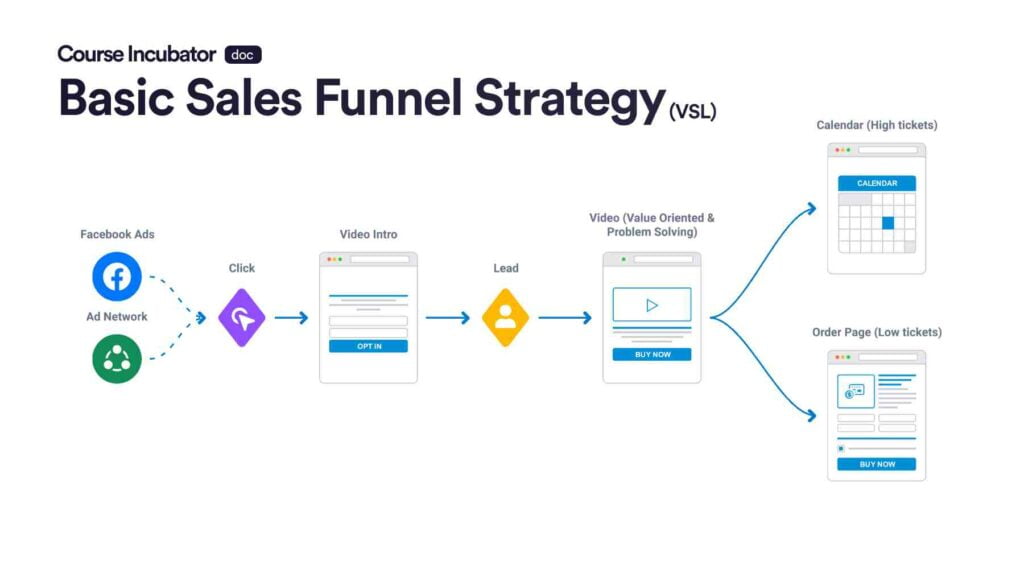
The Anatomy of a Sales Funnel: Stages Explained
There are different theories and views on the stages of a sales funnel. Generally, there are four stages a potential customer goes through. It starts with awareness and discovery, where they become aware of their needs and discover you. If the content you share resonates with them, they will become interested in what you offer and want to know more. This leads to deciding whether to buy your course or not. And, finally, if you’ve convinced them that what you offer is what they want and need, they will take action by adding your course to their shopping basket and making payment.
Awareness And Discovery
During this stage, your aim is to attract as many leads as possible. Research shows that the average conversion rate for online courses is in the region of 1.5%. So, for every 100 leads you attract, 1.5 will buy your course. And this is why we are going to show you how to create a high-converting sales funnel.
We become aware of needs, pain points, or problems that we want solutions for all the time. Or we have interests and hobbies that we want to know more about. What’s the first thing we typically do? We hit the internet or social media channels or speak to friends, family, and colleagues to gather as much information as possible.
Your role is to create content that addresses their needs and post it where they will most likely discover you.
HOW? The most successful and popular ways to be discovered are through your website, blogs, social media posts, SEO (search engine optimization), YouTube videos, and infographics. If you can afford to, paid social media and Google ads will give you better exposure.
Some questions to consider:
- How do they discover you?
- Where do they discover you?
- What do they see when they discover you?
- Will it make them interested?
Interest:
Now that they’ve discovered you, they will start evaluating you and comparing you with competitors to decide if you offer the best solution to their needs, pain points, or problems. Needless to say, this is where you must pull out all the stops to keep their interest.
Your aim here should be to get them to trust you and see you as an expert in your niche. From here, you can grow your customer base as your authority is built.
HOW? Get them to follow you on social media and, ideally, subscribe to a newsletter where you can regularly share content about the benefits of your course, how it will address their pain points or enhance their lives, what other people said through testimonials or reviews, and how it differs from similar courses. If a potential customer sees value in your free content, they’re more likely to buy paid content in the future.
Also, create lead magnets to draw them to your website or landing page and be sure to have a clear call to action (CTA) to get their email addresses. Examples of lead magnets are free PDFs or e-books that provide value, a snippet of your course, or a free webinar.
Some questions to consider:
- What happens when they first show interest in your course?
- How quickly do you respond to them?
- What are you doing to ensure they stop searching for other courses?
- How do you ensure they stay interested in what you have to offer?
Decision:
During this stage – sometimes referred to as the Desire Stage – prospects are very interested and feel confident that what you offer is what they need. But this is where budget considerations and value for money enter the picture.
They are aware of their problems and the different solutions. They know about you and your brand. At this stage of the funnel, you aim to show them that not buying your course is a mistake they can’t afford to make.
HOW? Do surveys to pinpoint their exact needs and use the information obtained to send targeted emails. Create self-assessments that lead to your course. Continue with free downloads, course snippets, invites to webinars, and more testimonials and case studies.
The offer is an important element in the decision-making stage. You can make your offer more attractive by promising results, or their money back, or a refund with no questions asked.
Some questions to consider:
- How do you reassure them that your course is right for them?
- How do you convince them that they are not wasting money?
- How do you give them peace of mind?
Action:
By now, you’ve successfully moved your leads from prospects to potential customers. The final step is to turn them into paying customers by making it easy for them to buy your course and assuring them it’s the best solution to their needs, pain points, or problems.
The last thing you want to do is guide them to the point of payment and then lose them because the process is over-complicated, unclear, or makes them feel uneasy or uncertain in any way.
HOW? To ensure the sales process is simple, straightforward, and easy to understand, you must test, test, test! Then add reviews and testimonials of happy customers on the payment page. Social proof is a great motivator. Offer compelling packages and discount codes. Break down exactly what they’re buying, what to expect, and how to contact you if they have questions. Offer complete peace of mind.
Some questions to consider:
- How easy is it to buy the course?
- How do you reassure them that everything is legit and not a scam?
- How do you ensure the entire process is user-friendly and easy to understand?
Role of a Sales Funnel in Online Course Sales: Why It Matters
Let’s recap why having a high-converting sales funnel for an online course is so important.
- It helps you to attract qualified leads.
- It turns your leads into prospects.
- It enables you to nurture relationships to turn prospects into customers.
- It’s a filtering process to ensure you end up with the right customers.
- The right customers stay loyal and give 5-star reviews and the best referrals.
- It grows your business.
BLUEPRINT FOR SUCCESS: HOW TO CREATE A SALES FUNNEL FOR YOUR ONLINE COURSE
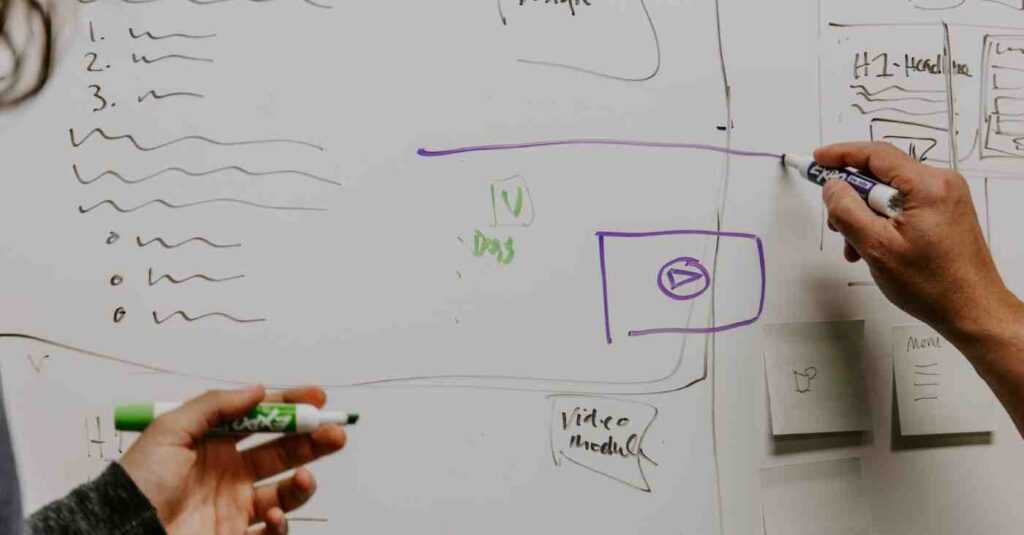
Now that you know what a sales funnel is and how it works, it’s time to focus on your ideal target market or target audience, the importance of a customer persona, how to ensure they engage with you, how to convert them into customers and, finally, how to turn them into raving fans.
Identifying Your Target Audience
It used to be enough to have a shotgun marketing approach and hope that somebody sees you, shows interest in what you offer, and buys from you. But one size fits all is now out of fashion. Consumers, especially those investing time and money like your course subscribers, want more personal interaction these days. They want to know that you designed your course with them in mind.
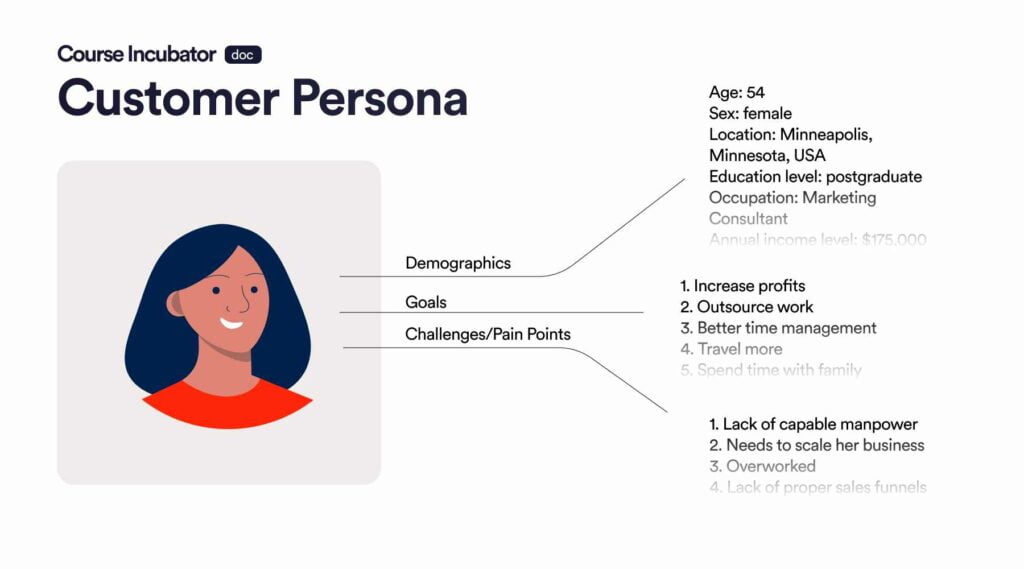
The Benefits of Knowing and Understanding Your Target Audience
Knowing your ideal target audience helps you create tailored course content that addresses their needs and interests. Your job is to spread that message across the right channels so that when they discover you, it is crystal clear that what you offer is what they need and want. You’ve got their attention, and down the funnel they go!
Now you want to keep them interested. This is where targeted marketing comes in, which is sending the right message to the right audience at the right time on the right channel that addresses their needs and aspirations.
But you can only do that if you know who you are talking to. The more personal the content and communication they receive, the higher the chances they’ll decide you’re the right fit.
One of the most important benefits of knowing, understanding, and effectively communicating with your target audience is that it leads to higher conversion rates. It leads to the action you want. Your high-conversion sales funnel for an online course works!
Another key benefit is that it saves you time and money. Instead of trying to reach a broad and unknown audience through as many marketing channels as possible, you can focus your efforts and budget on reaching them where you know they’ll find you.
Factors To Consider When Identifying Your Target Market
By understanding your target market’s demographics and geographics (age, gender, location, language, etc.) and their psychographics (interests, motivations, etc.), it’s much easier to know where to find them.
Are they more likely to use Google, LinkedIn, YouTube, Facebook, or other social media platforms?
How old are they, and what should your communication tone be with them? For example, how you communicate with a Baby Boomer will not be as effective with Gen X or Millennials.
Where do they live, and what language do they speak? What time should you post content, and in what language?
What is their current frame of mind? Are they anxious, excited, frustrated, sad, or happy? The tone of your message should make it clear that you understand their feelings, needs, and desires.
What are their skill levels about the topic of your course? Are they beginners, at an intermediate level or experts looking to stay on top of their game? All this knowledge puts you in a better position to create content that will appeal to your ideal target audience.
This brings us to a fun part of your marketing strategy, which is defining your ideal customer personas, also called buyer personas or avatars.
Defining an Ideal Customer Persona
Defining your ideal customer persona is a game-changer.
So, what exactly is it? It is a representation of your ideal customers, and you can have as many personas as you want. Using personas will help you tailor your marketing messages and sales strategies to resonate with your ideal customers.
And yes, this is where you can have fun because every customer persona needs a name. Something like Careful Clive, Excited Ella, Furious Fred, Ambitious Andy, Creative Carl, Happy Harry, or Nervous Nella.
One way to build personas is to create a form with relevant questions and send it to people you know. This will give you clarity and confirmation about whether the personas you have in mind are accurate.
Here are two examples of a persona.
Anxious Annie is 48, single, and has a demanding job. She leaves early and gets home late, leaving her dog, Homer, alone during the day. She keeps getting complaints from her neighbors that Homer barks at every stranger that walks by. She doesn’t want any conflict but also doesn’t have time to take him to obedience school. She is looking for an online course that will give her the skills to teach him not to bark at strangers. On her way to work, she often Googles on the train. She isn’t much into social media but follows several groups for pet owners on Facebook.
Eager Eddie is 26 and a software developer. He gets bored quickly and is looking for a new challenge. A friend recommended that he investigate Business Intelligence, seeing that he is computer savvy and enjoyed working in his dad’s business as a student to earn extra money. He is looking for an online course that he can do in his own time and still have time to spend with his new girlfriend. He uses YouTube as a search engine and is fast becoming a Tik-Tok fan.
Can you see that it’s easier to develop content when you have a clear image of your customer in mind?
Creating Captivating Course Landing Pages
A landing page (often called a lead magnet) is the entry point for potential customers, and it draws your customer personas into your sales funnel. That’s why spending time creating a captivating landing page is so important. Once they land on your page, it should immediately capture their attention, showcase the value of your course, and compel them to take action.
What’s the difference between a website and a landing page? Websites are for general exploration and research. There are usually different tabs showcasing what the business is about, how long it’s existed, all the services it offers, who the team is, some testimonials from happy clients, contact information, etc. A landing page is a stand-alone web page with one goal – to convert visitors into leads, then customers.
Just as we looked at the anatomy of a sales funnel, it’s essential to look at the anatomy of a landing page. The key components of an effective and captivating landing page are:
1. A catchy headline to grab your visitor’s attention. State your value proposition clearly and concisely. Add a supporting headline to persuade the visitor to stay, for example:
Headline: Become a Dog Training Master: Stop Your Dog from Barking at Strangers.
Sub-headline: Discover Proven Techniques to Transform Your Dog’s Behavior in Less than Three Weeks!
2. Images or short videos that support your offer and resonate with the target audience. Don’t use an image of Gen X when your target market is Gen Y. Don’t show an image of a business person when marketing to freelancers. Or, in the case of our barking dog – rather use a positive image of neighbors chatting and a dog playing in the background than an image of an angry, barking dog. Show the outcome, not the problem. Before and after images are always excellent converters!
3. Several clear calls to action. The aim is to get the visitors’ email addresses so that you can grow your email list of voluntary subscribers and follow them up to get them to take action. It’s essential to spread your CTAs over the page so that it’s easy for your visitors to act. You don’t want them scrolling up and down the page to engage with you. Examples of CTAs are: Sign Up for Our Newsletter, Download Your Free PDF, Get Our E-book Now, or Do Our Assessment Here.
4. Testimonials or reviews of happy customers act as social proof. It will confirm to your visitors that you are an expert in your field and that your course works. If this is your first course, don’t worry if you don’t have testimonials yet. You can add them later. The more real-life a testimonial, the better. For this reason a video testimonial can resonate with potential customers better than written words.
5. Killer content to answer questions like “What’s in it for me?”. List the outcomes of the course and use short case studies, success stories, and accurate statistics (with a credible source) where possible. Use bullet points and ensure the copy is clear, error-free, and easy to understand.
6. A closing argument is just as important as your opening headline. Think of the last court movie you saw. This is your final chance to convince the “jury” to vote in your favor by clicking on your CTA and giving you their email address.
Email Marketing and CRM Platforms: Streamline Your Strategy
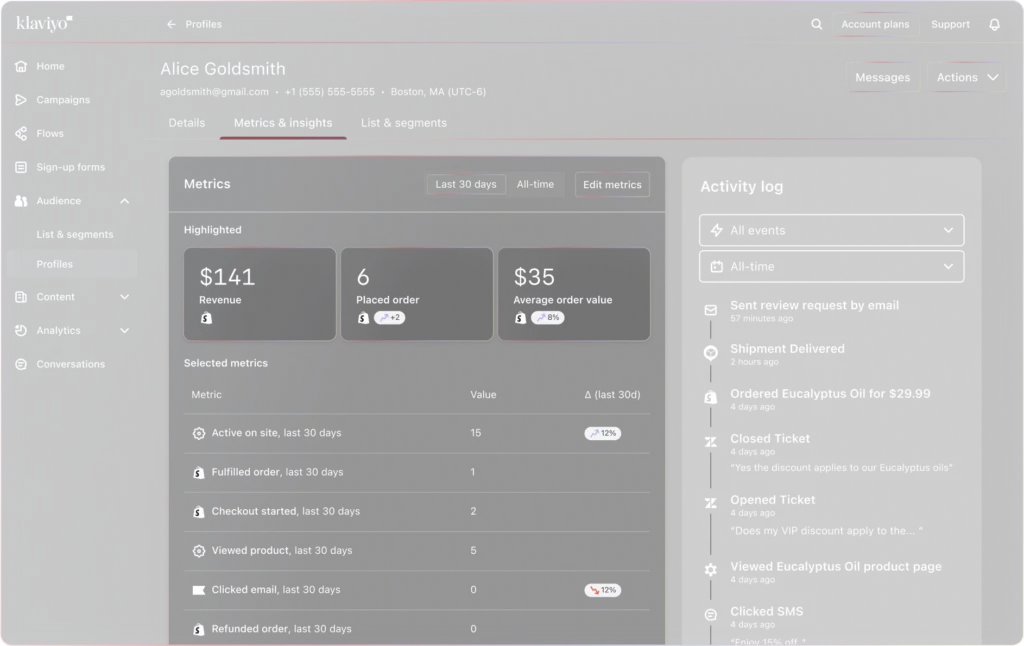
Okay. So now you’ve got a landing page that generates email addresses. But where do you store them? Many people still rely on an Excel spreadsheet to house the email addresses of leads, prospects, and clients. They then do complicated mail merges to send emails through their business email account. Don’t fall into that trap.
There are much easier ways of creating a consolidated and segmented database, which is a crucial part of your communication strategy and the success of your sales funnel.
You can choose between different tools and software to streamline the management and optimization of your sales funnel. Investing in a customer relationship management (CRM) system is a great start. Most include email marketing functionality or can be integrated with well-known email marketing platforms.
If you’re not ready to invest in a CRM platform, many email marketing platforms like MailChimp and AWeber also allow you to build a landing page. Some are free up to a certain number of subscribers.
There are many options around, so be sure to do thorough research.
Email Marketing Strategy: Nurturing Leads and Keeping Prospects and Potential Customers Engaged
Many people think email marketing is dead, but the opposite is true. email remains one of the most powerful tools for nurturing leads and keeping prospects and potential customers interested and engaged throughout the sales funnel.
Your email strategy starts with the very first email your new subscriber gets from you.
Examples of what not to do:
“Dear valued subscriber
Thank you for signing up for our newsletter.
The team at No More Barking.”
What to do instead:
“Hi Annie,
I appreciate your interest in our course on how to stop your dog from barking at strangers. We feel your pain. We know how frustrating it can be when your dog doesn’t listen, and people constantly complain about the noise.
This is the first of five emails where we will share more about the course and how our proven techniques will give you the results you want.
Watch out for the next mailer, where you’ll meet Harry and Stan, our expert dog trainers!
From one pet lover to another,
Pete and the team at No More Barking
P.S. If you are ready to buy the course, click here within the next 48 hours and qualify for a 5% discount!
With the last email, Annie will see that you care about her and her problem. You understand her pain points. You want to help her improve the quality of her life. She knows what to expect in the next mailer and is starting to feel a connection with you. She is, after all, going to “meet” Harry and Stan, and she certainly identifies as a pet lover—all the ingredients for a blooming relationship.
Subsequent emails should reinforce the information shared on the landing page because that’s what made her sign up in the first place.
Maintaining regular communication and providing valuable content builds trust and credibility with your subscribers, increasing the likelihood of conversions.
Components of a Good Email Strategy: Ensure Success
1. Segmentation: The only way to send personalized and relevant emails is by having a well-segmented email list that categorizes your audience according to some of the characteristics of your customer personas.
2. Engaging content: Create engaging content that aligns with your audience’s needs and interests. If you don’t consider yourself a good writer, hire a freelancer or use AI for inspiration to create compelling content and catchy subject lines.
3. Make it relevant and valuable: Send content that speaks to your customer personas. This is why a well-segmented email list is so important. Tag and segment your prospects so that you know when and what to send at the right time. There is a saying that if your email is for everyone, it’s really for no one.
4. Define the goals: You must have a definite plan for your email strategy. Whether it is nurturing leads, invitations to a webinar, or driving sales for your course, having clear goals will help you focus your time and efforts best.
5. Have an engaging subject line: The subject line will determine whether your email is read or not. It should be clear and concise and highlight the benefit of opening the email.
6. Be authentic: Don’t write in a way that is not true to you. Let your audience get to know you from the first contact. (If you use AI, please don’t just copy and paste – add your personal touch.)
7. Be professional: This shows your audience that you value them. Proofread before you send and test any links thoroughly.
Conversion Strategies: From Prospects to Customers
Apart from embarking on a personalized and segmented email marketing strategy with quality and relevant content, there are other ways to boost your conversion rates.
Use different channels to reach your prospective customers – this is called multi-channel marketing. Remember Anxious Anny and Eager Eddy? To reach Annie, you must market your course on Google and Facebook, but to reach Eddie, you must be on YouTube and TikTok. That’s why the more you know about your target audience, the better!
Review the data and insights you gather regularly. Identify the trends of when emails are opened, how LinkedIn posts perform, and how many likes and shares you get on social media.
Test different subject lines for emails and headlines for landing pages. What gets the most opens, likes, or actions?
Regarding payment, you can offer limited-time discounts, use scarcity tactics, or provide flexible payment options.
Post-Purchase Interaction: Maintaining Relationships and Encouraging Referrals
Finally! It’s time to look at referrals and word-of-mouth marketing. We explained previously that there are generally four elements to the sales funnel – Awareness and Discovery, Interest, Decision, and Action.
But if you want repeat business and good referrals, the sales funnel shouldn’t end with the purchase. Successful companies should always focus on building and maintaining customer relationships and encouraging referrals.
Continue with personalized post-purchase emails to provide ongoing support, share relevant articles, or ask for feedback. This makes it easier to send communication to upsell or cross-sell at a later stage.
Create a community through exclusive social media groups and encourage two-way communication. All of this promotes loyalty and turns customers into raving fans who love telling others about your excellent course.
FINE-TUNING YOUR SALES MACHINE: OPTIMIZATION AND OTHER CONSIDERATIONS
Traffic Generation Strategies: Organic and Paid Avenues
Two more concepts to get comfortable with are organic and paid marketing.
Organic marketing: Organic strategies include content marketing, social media engagement, search engine optimization (SEO), lead magnets, blogs, webinars, reviews, and testimonials. It is free unless you use an expert in the field to do it on your behalf and it is a more subtle approach than paid advertising. You can, of course, promote a lead magnet or webinar using paid advertising for greater reach and impact.
Paid marketing: Paid strategies involve online advertising through ads on Google, Facebook, Twitter, or LinkedIn, as well as Pay-Per-Click (PPC) to target a specific audience instead of waiting for them to discover you through organic marketing.
It’s worth repeating – the purpose of any marketing is to obtain an email address, so always remember your CTA!

A/B Testing or Split Testing: Experimenting with Different Variables
Are you ready for more important marketing advice? I hope so because this is a crucial part of sales funnel success.
Whether you share content through ads, landing pages, emails, or any other channel, always experiment with different variables, such as headlines, images, CTAs, pricing, offers, or email subject lines.
Take our dog training landing page as an example. Run one set of headlines over a specific period and then replace it with another (also catchy!) headline to see which performs better. Or, run two sets of headlines at the same time and compare results.
Headline 1: Become a Dog Training Master: Stop Your Dog from Barking at Strangers.
Sub-headline 1: Discover Proven Techniques to Transform Your Dog’s Behavior in Less than Three Weeks!
Headline 2: Tired of Your Neighbors’ Complaints? Learn How to Stop Your Dog from Barking Now!
Sub-headline 2: You’ll Wish You Signed Up Years Ago.
A/B testing is the best way to gather important data and insights on what resonates best with your audience. It will increase the effectiveness of your marketing efforts and conversion rates, and it’s easy to do.
Analytics and Metrics: Understanding What Works
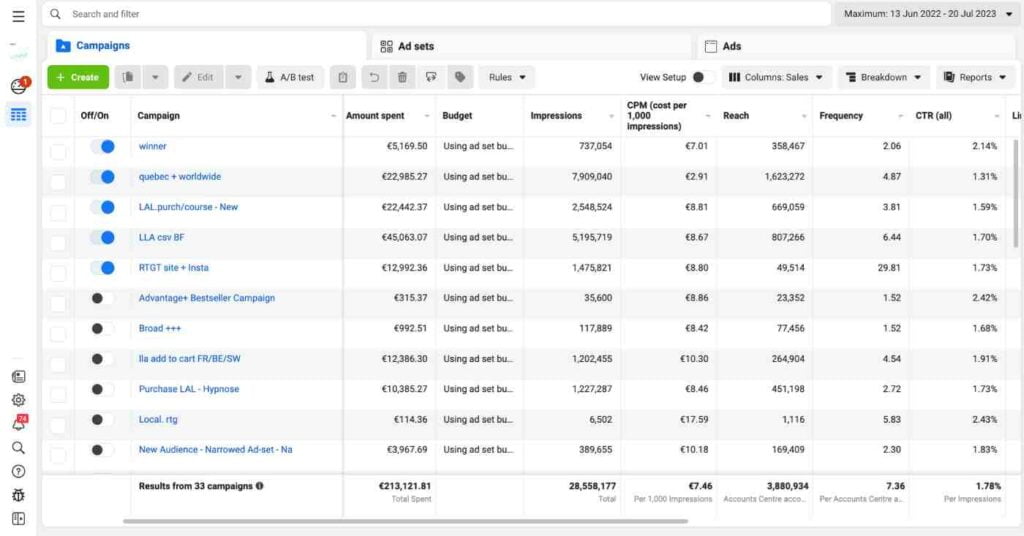
Why is gathering data so important? It lets you make data-driven decisions about your marketing strategies rather than working on a gut feeling. It helps you to understand the effectiveness of your sales funnel and shows you where to make changes.
Some of the most important metrics to track are the volume of leads, daily sign-ups, email open rates, conversion rates, acquisition costs, total sales, and cycle times.
Regularly reviewing and analyzing this data is the only way to improve tactics and processes to beat your competitors. Recommended tools include Google Optimize, Google Analytics, and Hotjar.
Retargeting and Remarketing: Capturing Missed Opportunities
Of course, not every subscriber to your email list will become a customer. The first time around that is. Remember, they ended up on your landing page and email list for a reason. They have previously shown interest in your course, but maybe it wasn’t the right time.
Yes, you must be careful about how and when you do it, but retargeting and remarketing efforts when you launch a new course or update the initial one can re-engage those who left the tunnel during the Awareness, Interest, or Decision stage.
Remember to retain all contact details unless someone unsubscribes from your list.
You can also leverage the power of Facebook advertising to grow your mailing list.
Leveraging Tools and Software to Streamline Your Funnel
We mentioned previously that there are various tools and software available to streamline the sales funnel. There are customer relationship management (CRM) systems and email marketing platforms with landing page builders. But there are also different analytics tools and automation software to streamline sales processes, track customer interactions, and automate specific marketing tasks.
Don’t try and do everything yourself. It’s an impossible task. Instead, leverage the right tools to enhance efficiency, improve conversions, provide a seamless experience for potential customers, and create a loyal customer base.
CASE STUDIES: SUCCESSFUL SALES FUNNELS IN ACTION
Examples of Successful Online Sales Funnels
Let’s have a look at four of the most successful sales funnels.
Apple Music is one of the best examples we’ve seen. Their catchphrase: Get over 100 million songs free for 1 month. Now who wouldn’t want that?
Amazon Prime offers a 7-day free trial and follows up with prospects regularly to entice them to return if they did not sign up after the trial.
MailChimp offers a limited free account and is super easy to use. The deal clincher – no credit card details are required to use the platform.
Key Takeaways from Success Stories
Remembering that different strategies will work for different target markets is important. Do your research. Become a lead for someone else’s course and rate the experience. See what your competitors are doing using Facebook Ad Library. See where you can improve. Learn where you can.
CONCLUSION
Recap of Sales Funnel Strategy for Online Course Sellers
A sales funnel is crucial to attract the right target audience to your course. Creating a high-converting sales funnel course will take time and effort, but it will be one of the most rewarding ways to invest your energy. It will ensure that your carefully created course matches the right customer.
Why Continuous Improvement and Adaptation is Crucial in Sales Funnel Management
Developing a sales funnel is not a once-off exercise. It needs continuous improvement based on accurate data and insights. Use the metrics available to you. Ask your customers for feedback. Then act on that feedback to improve the process for future customers.
Final Words: Empowering Your Online Course Business with Effective Sales Funnels
Think of your sales funnel as a journey you’re taking your target audience on. During this journey, you should consider every touchpoint or interaction they have with you. From where they discover you, become interested, and decide you’re a good fit to where they turn into customers and, ultimately, raving fans.
A sales funnel is not just another marketing concept. It is the key to your success.
Ready to take your online course to the next level?
Course Incubato specializes in marketing services for online course creators just like you. Book a discovery call today and let us help you devise a personalized marketing strategy that will turn your leads into enrollments. Don’t let marketing hurdles hold you back. Together, we’ll make your online course a resounding success!
